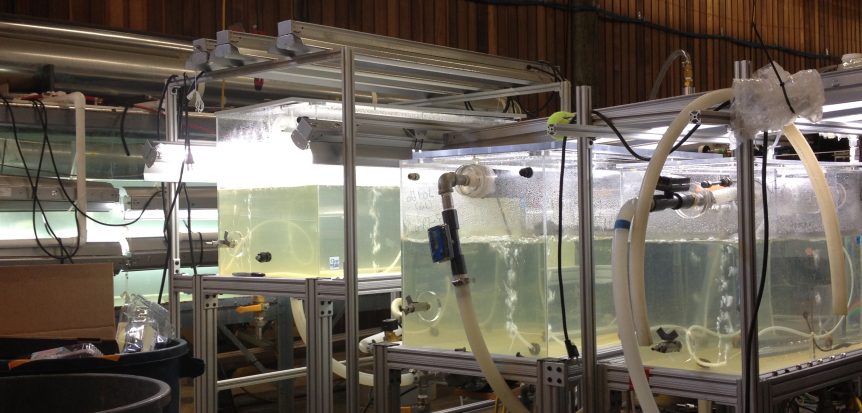When waves crash and underwater bubbles burst at the surface, tiny particles are ejected from the ocean into the atmosphere. As the water evaporates away, a particle is left behind that we call sea spray aerosol. Our research through the Center for Aerosol Impacts on Climate and the Environment (CAICE) is focused on understanding the physical, chemical, and biological processes that affect the composition sea spray aerosol. Knowledge of this composition is critical to understanding the effect of sea spray in the atmosphere, such as how it reacts and how it affects cloud formation.

Marine Aerosol Reference Tanks (MART) provide a unique opportunity to capture sea spray aerosol in the laboratory
During the IMPACTS field experiment at Scripps Institute of Oceanography in La Jolla, California, we are collecting samples of ocean water, sea surface microlayer, sea foam, and sea spray aerosol from the wave flume and Marine Aerosol Reference Tanks (MART). We transport these samples back to our laboratories at the University of Iowa, where we measure individual organic molecules and inorganic ions. We use liquid chromatography (LC for short) that allows us to separate compounds of interest from the complex environmental sample. Conductivity, electrochemistry, and mass spectrometry provide sensitive methods of detection that allow us to quantify trace amounts of compounds. By determining the distribution of chemicals across the phases of the ocean and atmosphere relative to one another, we can characterize the selective processes that lead to organic molecule enrichment in sea spray aerosol. Collaborating in the IMPACTS field study means that we can combine our knowledge of chemistry with evolving ocean biology and the physical properties of the sea spray aerosol.

CAICE researchers (clockwise) Hosiana Abewe, Olga Laskina, Jon Trueblood, Thilina Jayarathne, and Grace de Dieu Irumva testing a laboratory experiment on the measurement of surface reflectivity (a.k.a. albedo)
In addition to conducting research, CAICE provides an opportunity to engage with students and the community in learning about climate science. I had the pleasure of teaching at the California State Summer School for Mathematics and Science (COSMOS) while at UCSD earlier this month. I worked with undergraduate and graduate students to design and adapt curricula about global change and climate for high school students. Together, we explored how the earth’s surface affects our energy balance with the sun, how some gases cause greenhouse warming, and how different molecules interact with solar energy.
I am thrilled to be part of a dynamic research center that combines cutting-edge research, innovation, and education about climate science. Through this summer’s IMPACTS experiment, we have new capabilities to understand complex environmental processes through intricately-designed laboratory experiments.
Elizabeth Stone, Assistant Professor, Department of Chemistry, University of Iowa

